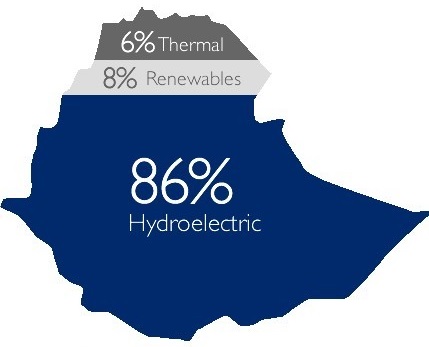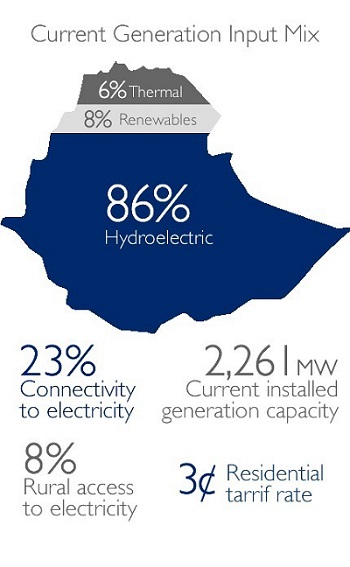
Ethiopia’s Energy Sector: The Government of Ethiopia, under its latest Growth and Transformation Plan (GTP), envisions transitioning from a developing country to a middle-income country by 2025. Ethiopia’s ability to achieve this ambitious goal in such key sectors as agriculture and industry is significantly constrained by current challenges in the power sector. Although Ethiopia is endowed with abundant renewable energy resources and has a potential to generate over 60,000 megawatts (MW) of electric power from hydroelectric, wind, solar and geothermal sources, currently it only has approximately 2,300 MW of installed generation capacity to serve a population of over 95 million people.

The targets for increasing generation capacity to 10,000 MW established under the first iteration of the GTP will be met by completion of two major hydro power plants in 2017 and 2018. The current GTP has a new target to increase generation capacity to over 17,000 MW by 2020, with an overall potential of 35,000 MW by 2037, which would help sustain Ethiopia’s continued economic growth and enable it to become a regional renewable energy hub in East Africa. The Government of Ethiopia has determined that private sector investment is critical to achieve these aggressive power generation targets, but acknowledges that it lacks sufficient experience with Independent Power Projects (IPPs). The Government of Ethiopia also faces other major challenges in expanding the country’s energy system, including the need to rehabilitate an aged distribution system with high Losses and ensure more efficient operation and maintenance of the expanded system It must also become a creditworthy purchaser of electricity from IPPs, address foreign exchange constraints, reform tariffs to allow for full-cost recovery, and deliver more power to the majority of the population living off-grid.
Power Africa Support
Power Africa is supporting Ethiopia’s energy development strategy through wide-ranging technical assistance in cooperation with Sweden, Norway, the World Bank including the International Finance Corporation, European Commission, the UN, DFID, and other development partners, by:
- assisting with the development of new laws and regulations that will facilitate private-sector led IPP investments in geothermal, solar, wind, hydro, and biomass projects;
- assisting with negotiations and bring to financial closure the Government of Ethiopia’s initial landmark IPP for the Corbetti and Tulu Moye geothermal projects that will generate up to 1,000 MW;
- assisting with new IPPs and Government of Ethiopia’s desire to transition to competitive tendering;assisting with the planning, operation, and maintenance of generation, transmission, and distribution systems as they are expanded;
- developing the grid code that specifies the rules and responsibilities for all energy stakeholders;
- developing a plan to reduce distribution losses and assist with introduction of “smart grid technology;”
- improving Government of Ethiopia contracting for supply, installation, and construction to ensure full realization of lifecycles for equipment and facilities;
- strengthening the Ethiopian Electricity Authority to perform as an effective regulator and assist with determining cost reflective tariff rates;
- supporting access to off-grid electricity
In addition, Power Africa is supporting the Eastern Africa Power Pool, which is based in Ethiopia. The power pool is mandated to facilitate cross border trading of renewable energy at the lowest possible cost and to efficiently manage a regionally integrated system. Power Africa support includes development of common codes for the regional network, tracking interconnecting transmission lines, and training for power pool and member countries to analyze and operate the regional power system.
About Power Africa
Power Africa is a multi-partner initiative launched by President Obama in 2013. Power Africa’s goals are to increase electricity access in sub-Saharan Africa by adding more than 30,000 megawatts of cleaner, more efficient electricity generation capacity and 60 million new home and business connections.
Read more on USIAD
——
See also:
- GERD and Koysha Dam: The Dams of the Future
- The Grand Ethiopian Renaissance Dam Gets Set to Open
- Gibe III Hydroelectric Project Doubles Ethiopia’s Capacity
- Development of Ethiopia’s Grand Ethiopian Renaissance Dam (GERD)
- Ethiopian Electric Power and Standard Bank Reach 100M USD Loan Agreement
